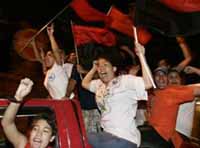Nicaragua: Ortega is back
The former Marxist revolutionary won the presidential vote in the first round, according to preliminary results and exit polls. His conservative rival says he obtained enough votes to force a runoff.

Waving the historical red-and-black flags of the Sandinista guerrillas that overthrown the US-backed bloody dictator Anastasio Somoza in 1979, supporters of Daniel Ortega begun celebrating early in the morning what it has been later confirmed: their leader returned to power. According to preliminary results and exit polls released on Monday morning, Ortega won Sunday’s presidential vote in the first round upsetting the expectations of his conservative rival, Eduardo Montealegre, to force a runoff.
With returns in from almost 15 percent of polling stations, the 60-year-old Ortega had just above the 40 percent mark that would seal a first-round win and give him back the presidency 16 years after he was voted out at the end of a brutal civil war against U.S.-backed Contra rebels. Exit polls of the respected and independent group called Ethics and Transparency, show that Ortega obtained 38,5% of the vote as Montealegre trailed with 29,5%. Ortega needs either 40 percent of the vote, or 35 percent with a 5-point lead, to take a first-round victory, according to the country’s Constitution.
As foreign observers rushed to confirm that the election complied with international standards, Montealegre, who was Washingoton’s sponsored candidate, insisted his party’s numbers showed he won enough votes to force a runoff.
Only U.S. officials in Nicaragua said they found irregularities and refused to back the election until the returns were in and problems of polling stations opening late and closing early were investigated. But at that time, militants of the Sandinista Front for the National Liberation (FSLN, by its initials in Spanish) were filling the streets in the surroundings of Managua, notoriously in the revolutionary area named “Soviet Union”.
Meanwhile, senior party members hugged each other, some of them crying with joy, at a party in the capital Managua. Most of them were part of the rebel guerrillas that toppled Somoza in 1979 to fight then the US-trained Contras.
But a second rule of Ortega could be very different from his previous one, when he was the leader of a triumphant Marxist guerrilla backed by Cuba and the Soviet Union. Many prominent members of the Sandinista movement left the party late in the nineties, after Ortega closed the notorious deal with former president Arnoldo Aleman – now sentenced to 20 years for corruption- that divvied up power between the Liberals and the Sandinistas in advance of Aleman's exit from office.
Also, Sandinista dissidents horrorized when it became known that in his attempt to return to power, Ortega also negotiated support from prominent Contra leaders. Among them, Mr. Ortega's running mate is former Contra heavyweight Jaime Morales, whose mansion Ortega still lives in after seizing it in the 1979 Sandinista revolution that toppled the Somoza family dictatorship.
“This is not Sandinism, this is Danielism”, told Pravda.Ru the famous USSR condecorated Nicaraguan poet and Minister of Culture under the Sandinista rule, Ernesto Cardenal, in a recent conversation in Buenos Aires. He, as well as other dissidents supported the former Managua mayor Hearty Lewites, who died during the campaign.
Although Ortega has moderated his leftist rhetoric, Washington fears he could join Venezuela and Cuba in the Latin American anti-US bloc. From Caracas, President Hugo Chavez has openly supported Ortega and celebrated his victory as his own.
Hernan Etchaleco
Pravda.ru
Subscribe to Pravda.Ru Telegram channel, Facebook, RSS!



